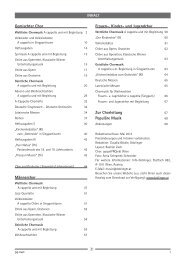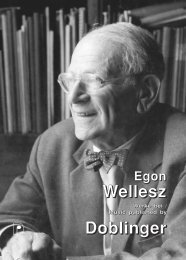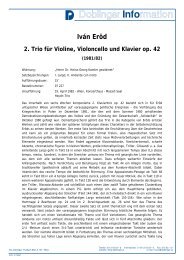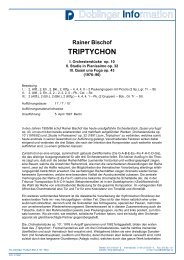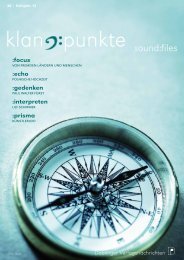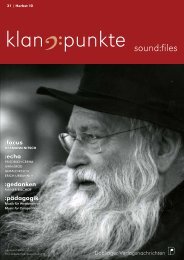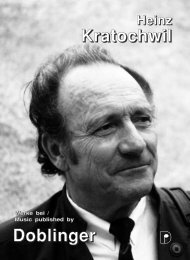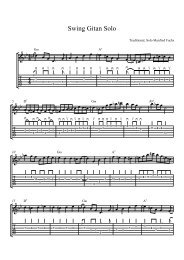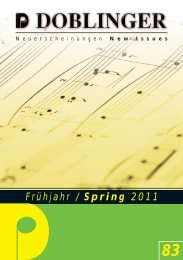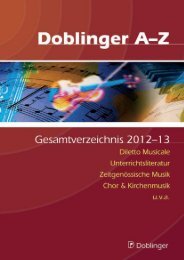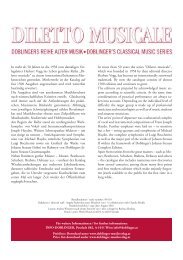Iván Eröd Doblinger - bei Doblinger-Musikverlag
Iván Eröd Doblinger - bei Doblinger-Musikverlag
Iván Eröd Doblinger - bei Doblinger-Musikverlag
Sie wollen auch ein ePaper? Erhöhen Sie die Reichweite Ihrer Titel.
YUMPU macht aus Druck-PDFs automatisch weboptimierte ePaper, die Google liebt.
1970 Austrian State Award<br />
1971 Supportive Award of the Theodor Körner Foundation<br />
1974 Supportive Award of the Vienna City Council<br />
1975-89 Residence in Graz<br />
1978 Appreciative Award of the Graz City Council<br />
1980 Appreciative Award of the Austrian Federal Ministry of Arts and Education<br />
1981 Styrian Music Award<br />
1986 Vienna City Council Music Award<br />
1988 Guest Professor at the Vienna Music University<br />
since 1989 Full Professor for harmony and counterpoint at the Vienna Music University<br />
1993 Award of the Budapest Béla Bartók / Ditta Pásztory Foundation; buys a farm house<br />
in Csákberény in Western Hungary<br />
2001 City of Vienna Gold Order of Merit; Republic of Austria Great Silver Order of Merit<br />
Unrestrained mirth and utmost seriousness mark the oeuvre of <strong>Iván</strong> <strong>Eröd</strong> and thus reflect two<br />
significant traits of the composer’s character. Unlike these personal attributes, which can be traced<br />
as parallel strands through the entire oeuvre, the technical means employed can be more readily be<br />
assigned to individual stages in his development. Whereas the early works of his Hungarian phase<br />
stand especially under the influence of Bartók, Kodály, and Hungarian folk music, <strong>Eröd</strong>’s works<br />
written immediately before his emigration, as well as – most importantly – those composed during<br />
his studies with Karl Schiske at the Vienna Music Academy, reflect – similarly to many of his<br />
contemporaries – his experiences with the dodecaphony of the “Second Viennese School” and with<br />
its extension, serialism. Thus, works as the Wind Trio op. 4 (1957, rev. 1987) or the Ricercare ed<br />
Aria op. 11 for wind quartet (1965) are based on twelve-tone structures. The experiences gathered<br />
in the early 60s as a performer, chamber musician and vocal accompanist led <strong>Eröd</strong> to adopt<br />
a musical-technical idiom that is more readily understandable both for musicians and audience.<br />
Already during the work on his opera Die Seidenraupen (”The Silkworms”, 1964 - 68), an initially<br />
strict serial structure gave way to a freer treatment. With his First Violin Sonata op. 14 (1969/70),<br />
<strong>Eröd</strong> finally returned to a new tonality resp. to a new tonal orientation. Ever since, his main aim is<br />
at a thoroughly sophisticated tonal language that nevertheless can be understood by a wider<br />
audience. The main difference to conservative tonal composers of that time lies in the variety of the<br />
tonal material employed (for example modal scales, “gypsy” scales, etc.); and on the other hand in<br />
the integration of serial elements – thus, for example, the second of the Three Pieces for Solo<br />
Violin op. 27 (1978/79), March, has a strict serial structure based on a seven-tone scale. Other<br />
elements of contemporary music also belong firmly to <strong>Eröd</strong>’s musical idiom, for example<br />
instrumental or metrical techniques (for example the “senza misura”-parts in the operas or in the<br />
orchestral work Soirées imaginaires op. 38, 1981). Far from <strong>bei</strong>ng programmatical, many works<br />
nonetheless contain references to autobiographical experiences or to historical events: the Violin<br />
Concerto op.15 (1973), for example, the Krokodilslieder (”Crocodile Songs”, op. 28, 1979/80), the Viola<br />
Concerto op. 30 (1979/80), or the Second String Sextet op. 68 (1996) all point to the composer’s<br />
intimate relationship to his wife and children; and the experience of his family’s racial persecution<br />
during his childhood is reflected in the song cycle Über der Asche zu singen op. 65 (1994). As a rare<br />
case of simultaneous work on two pieces, the Bukolika for chamber ensemble op. 64 (1994) – written<br />
parallel to the song cycle – reflects the idyll of the Hungarian rural life regained shortly before in a<br />
detached manner. A specific characteristic of <strong>Eröd</strong>’s music is furthermore the use of Hungarian<br />
elements (most notably in the Violin Concerto, the First Piano Trio op. 21, 1976, the Quintetto<br />
ungherese op. 58, 1990, and in the First Symphony “From the Old World” op. 67, 1995), but also the<br />
influence of Jazz and Blues, such as in the Piano Concerto op. 19 (1975) and in the Minnesota Sinfonietta<br />
op. 51 (1986). The delight in incorporating folkloristic elements results also in the whimsical and merry<br />
character of many works. Contrasting to this “lighter”, entertaining, aspect are, among others, works<br />
like the Viola Concerto op. 30 (1980) and the Second Piano Trio op. 42 (1981/82). <strong>Eröd</strong> is at his<br />
most serious in some of his vocal works, as in the Vier Gesänge op. 49 (1983), the cycle Schwarzerde<br />
for Baritone and Orchestra op. 49 (1984/85) and in the cantata Voc Lucis op. 56 (1988/89).<br />
Christian Heindl,<br />
transl. Nicolas Radulescu<br />
5



